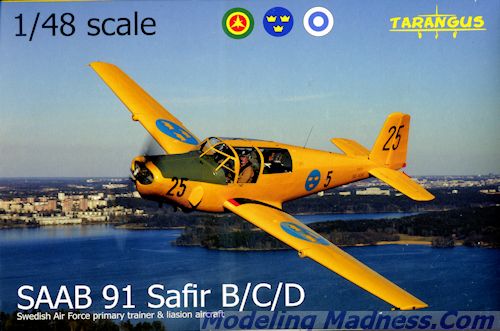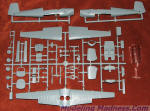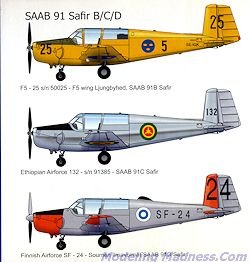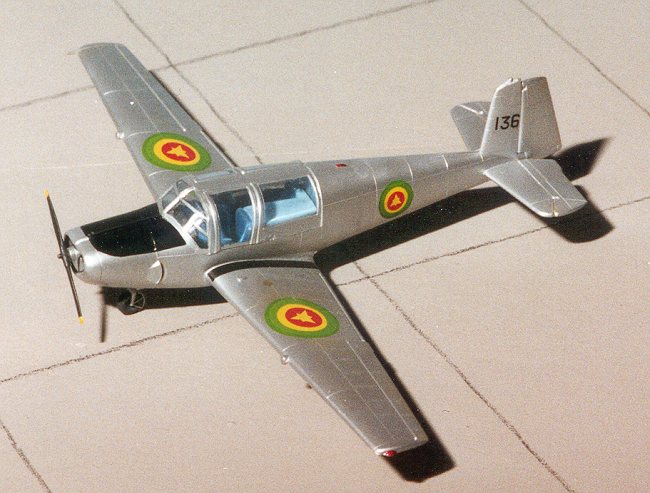
| KIT #: | TA 4804 |
| PRICE: | $49.00 from www.coopersmodels.com |
| DECALS: | Four options |
| REVIEWER: | Scott Van Aken |
| NOTES: | New tool short run kit |

| HISTORY |
The Saab 91 Safir (Swedish: "sapphire") is a three (91A, B, B-2) or four (91C, D) seater, single engine trainer aircraft. The Safir was built by Saab AB in Linköping, Sweden, (203 aircraft) and by De Schelde in Dordrecht, Netherlands (120 aircraft).
The Safir's first flight on 20 November 1945. The all-metal Safir was designed by Anders J. Andersson, who had previously worked for Bücker, where he designed the all-wood Bücker Bü 181 "Bestmann". The Safir thus shared many conceptual features of its design with the Bestmann.
The Saab 91A is powered by a 125 hp four cylinder de Havilland Gipsy Major 2c piston engine, or a 145 hp Gipsy Major 10 piston engine. The 91B, B-2 and C have a six-cylinder Lycoming O-435A engine with 190 hp. The 91D has a four-cylinder Lycoming O-360-A1A engine with 180 hp.
The "Safir" was later used as a platform to test at low speeds the new swept wing for the Saab 29 and Saab 32 jet fighters.
323 units were built in 5 versions (A, B, B-2, C and D). The Safir was used by the Swedish, Norwegian, Finnish, Austrian, Tunisian and Ethiopean air forces as a trainer aircraft, and a single aircraft was used by the Japan Defense Agency as an STOL test platform.
Major civilian users were Air France, Lufthansa and the Dutch Rijksluchtvaartschool (RLS) on the Groningen Airport Eelde, near Groningen.
During development of the Saab 29, the initial Saab 91 prototype was modified with a scaled down version of the Saab 29's swept wings; this aircraft was designated Saab 201 Experimental Aircraft. This same airframe was later fitted with wings designed for the Saab 32 Lansen; this was designated Saab 202.
A single Saab 91 Safir was modified as the Saab X1G for research in Japan.
| THE KIT |
 Tarangus
is a short run kit maker in Sweden that specializes in Swedish aircraft that are
not produced by others. So far, they have worked in 1/48 and this is their
second kit, the first being the J.32 Lansen. Those who have read my build
article on the Lansen know that it was not a quick and easy build as is often
the case with first kit short run kits. The Safir is not as complex and should
prove to be a more straight-forward build.
Tarangus
is a short run kit maker in Sweden that specializes in Swedish aircraft that are
not produced by others. So far, they have worked in 1/48 and this is their
second kit, the first being the J.32 Lansen. Those who have read my build
article on the Lansen know that it was not a quick and easy build as is often
the case with first kit short run kits. The Safir is not as complex and should
prove to be a more straight-forward build.
Those who are not fans of engraved rivets will be pleased to know that this kit has none of those. It appears that the kit was molded on a single sprue, which was cut to allow it to fit into the zip bag one finds upon opening the end opening box. The two fuselage halves a full length and include the rudder. The three piece wing (one piece lower and two upper halves) have separate ailerons and the tail planes are single pieces on each side. The 'fabric' areas are represented by raised lines where the stringers would be. This basically represents properly taught fabric.
The cockpit is probably the most complex part of the build. There is a nice cockpit floor, which on the underside will house the nose gear well and the main gear wells. Flipping it over, there are two separate front seats with a pair of seats for the back. Some Safirs were three seat planes with the smaller left rear seat removed and a box compartment in its place. This is provided and in fact there are separate build instructions depending on the variant one is modeling.
In the front of the cockpit are a pair of control sticks, a flap handle as well as a nicely done instrument panel with raised detail, two sets of rudder pedals and the instrument panel anti-glare panel. There is a rear bulkhead and there is some detail on the inside of the fuselage. Since this is an air-cooled engine, there is an upper engine detail section you will be able to see through the front cowling piece. This is for the six-cylinder Lycoming engine so it would not be correct for the Finnish version which used the four-cylinder engine. However, most will not spot the difference.
The kit provided two different propellers depending on the variant being modeled. The main gear wheels are in two halves with the nose gear integral with the nose wheel. Additional bits are a DF antenna and a prop spinner for the Finnish version as well as different exhaust. Obviously Tarangus has done their research in the different variants. A one-piece canopy covers all this. The canopy is quite clear so all the interior detail should be easy to see.
Instructions are well drawn and offer generic color
references. There is a large decal sheet that provides markings for three planes. First off is a Swedish Air Force
version in overall yellow as sho
sheet that provides markings for three planes. First off is a Swedish Air Force
version in overall yellow as sho wn
on the box photo. This is a warbird and if you so with to build your kit as
such, the civil registration is included. If doing the military version, simply
leave it off. Next is a silver Ethiopian Air Force version followed by a Finnish
aircraft with large da-glo sections. These may have been international orange,
but I'm betting on the da-glo, judging from period photos. This scheme is also
found o a warbird. Apparently Safirs were grabbed up by eager buyers once they
left military service. Stencil placement is provided in the instructions
while painting and major decal placement is on the back of the box. Decals are
quite nicely printed and should work just fine. The black nose anti-glare panel
and wing walk areas will need to be painted on all options.
wn
on the box photo. This is a warbird and if you so with to build your kit as
such, the civil registration is included. If doing the military version, simply
leave it off. Next is a silver Ethiopian Air Force version followed by a Finnish
aircraft with large da-glo sections. These may have been international orange,
but I'm betting on the da-glo, judging from period photos. This scheme is also
found o a warbird. Apparently Safirs were grabbed up by eager buyers once they
left military service. Stencil placement is provided in the instructions
while painting and major decal placement is on the back of the box. Decals are
quite nicely printed and should work just fine. The black nose anti-glare panel
and wing walk areas will need to be painted on all options.
| CONCLUSIONS |
 I am very pleased to see this kit being produced,
especially as I am a fan of trainers. I am expecting this to build just like a
standard short run kit, but without having to deal with resin or photo etch, for
which I'm grateful. Since only a few of the nations who have operated this plane
are covered in this boxing, I anticipate other boxings, including one with some
particularly fetching civil schemes. I should point out that if this is like the
Heller 1/72 kit I built many years ago, it will be incredibly tail heavy.
Finding room for weight will be a bit of a challenge. The instructions make no
mention of it, but you'll need to pack every available nook forward of the main
gear with weight to keep it from tail sitting.
I am very pleased to see this kit being produced,
especially as I am a fan of trainers. I am expecting this to build just like a
standard short run kit, but without having to deal with resin or photo etch, for
which I'm grateful. Since only a few of the nations who have operated this plane
are covered in this boxing, I anticipate other boxings, including one with some
particularly fetching civil schemes. I should point out that if this is like the
Heller 1/72 kit I built many years ago, it will be incredibly tail heavy.
Finding room for weight will be a bit of a challenge. The instructions make no
mention of it, but you'll need to pack every available nook forward of the main
gear with weight to keep it from tail sitting.
| REFERENCES |
http://en.wikipedia.org/wiki/Saab_Safir
August 2014 Thanks to www.coopersmodels.com
for the preview kit. You can find this one at the link to the left. If you would like your product reviewed fairly and fairly quickly, please
contact
the editor or see other details in the
Note to
Contributors.